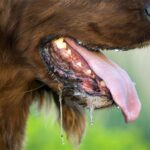How To Stop Bleeding Lump On Dog
How to Help Your Dog Stop Bleeding from a Lump: Tips and Tricks for Pet Owners
If you notice a lump on your dog that is bleeding, it can be scary and overwhelming. However, there are steps you can take to address the issue and help your furry friend feel better. In this article, we will explore some common causes of bleeding lumps on dogs, how to assess the situation, what home remedies may work, when to seek professional veterinary care, and how to prevent similar problems in the future. By reading this article, you will learn how to become a more informed and proactive pet owner who can handle emergencies with grace and confidence.
Causes of Bleeding Lumps on Dogs
There are many reasons why a dog may develop a lump that bleeds. Some possible causes include:
– Trauma: if your dog gets into a fight with another animal or hits an object hard, they may suffer from bruises or cuts that turn into lumps over time.
– Infection: if a wound or cut on your dog’s skin becomes infected with bacteria or fungi, it may form an abscess that can burst and bleed.
– Allergy: some dogs develop allergic reactions to certain substances in their environment or food, which can cause skin irritation, itching, and scratching that damages the skin and leads to lumps.
– Cancer: unfortunately, some lumps on dogs are cancerous tumors that require surgery or other treatments to remove or manage.
Assessing the Situation
Before you try any home remedies for your dog’s bleeding lump, you should assess the severity of the problem. If your dog is bleeding profusely or seems weak or lethargic, you should seek immediate veterinary assistance. However, if the bleeding is minor and your dog appears alert and active, you can try some first aid measures at home.
Home Remedies for Bleeding Lumps on Dogs
Here are some tips to help your dog stop bleeding from a lump:
– Apply pressure: use a clean cloth or gauze to apply gentle pressure on the lump for a few minutes. This can help stop the bleeding and promote clotting.
– Clean the wound: if the lump is bleeding from an open wound, you should wash it with warm water and mild soap to remove dirt and debris. Then, pat it dry with a clean towel or paper towel.
– Use styptic powder: this product contains a chemical that can help stop bleeding by constricting blood vessels. You can apply it directly to the lump or use a cotton swab to dab it on.
– Use herbal remedies: some herbs, such as calendula, chamomile, and tea tree oil, have antibacterial and anti-inflammatory properties that can aid in wound healing and reduce swelling. You can make a poultice with fresh or dried herbs and apply it to the lump, or use diluted essential oils as directed by your vet or an aromatherapist.
– Give your dog pain relief: if your dog seems uncomfortable or in pain due to the bleeding lump, you can give them some over-the-counter pain medication that is safe for dogs, such as aspirin or ibuprofen. However, you should always consult your vet before giving any drugs to your dog, especially if they have other health issues or are taking other medications.
When to Seek Professional Veterinary Care
If your dog’s bleeding lump does not improve within a few days of home treatment, or if it gets worse despite your efforts, you should take them to see a veterinarian. Your vet may need to perform tests such as blood work, x-rays, ultrasound, or biopsy to determine the cause of the problem and recommend appropriate treatment options. Depending on the severity of the issue, your dog may need surgery, antibiotics, chemotherapy, radiation therapy, or other interventions.
How to Prevent Similar Problems in the Future
To reduce the risk of your dog developing bleeding lumps, you can take some preventive measures, such as:
– Keep your dog’s environment clean and safe: make sure your dog’s living space is free from hazards such as sharp objects, toxic substances, or aggressive animals. Clean your dog’s bedding, toys, and dishes regularly to prevent bacteria and fungi from growing.
– Monitor your dog’s skin health: check your dog’s skin regularly for any signs of lumps, bumps, rashes, or sores. If you notice anything unusual, take a photo of it and keep a record of its size, shape, color, and location. This can help you detect changes over time and seek prompt veterinary attention if needed.
– Feed your dog a healthy diet: provide your dog with high-quality food that contains balanced nutrients and vitamins that support their immune system and skin health. Avoid giving your dog table scraps or processed foods that may contain allergens or additives that can harm their health.
– Exercise your dog regularly: give your dog plenty of opportunities to run, play, and explore outside. This can help them maintain a healthy weight, strengthen their muscles and bones, and improve their mental well-being.
Conclusion
Dealing with a bleeding lump on your dog can be stressful and challenging. However, by following the tips and tricks we have shared in this article, you can become more prepared and confident in handling such emergencies. Remember to stay calm, assess the situation carefully, apply basic first aid measures if appropriate, seek professional veterinary care when necessary, and take preventive steps to avoid similar problems in the future. Your dog deserves the best care possible from a loving and responsible pet owner like you!



